
Business structures
We discuss business partnerships, limited companies and sole proprietorship.

Got a big idea? Find out how to protect it
The Intellectual Property (IP) rights of your business determine the value of your idea, so a copyright, patent or trademark is essential.
Once you’ve had a great idea, checked that no-one else has already had it and confirmed that it’s commercially viable, you should start to think about protecting it.
If your work is original and tangible then it’s automatically protected under copyright laws. This means that it has to be an idea that no-one else has had before, and you have to have physically expressed that idea – it can’t just be in your head. This is most commonly useful when it comes to creative works such as illustration, photography, literary pieces, web content and music.
You can mark works with the copyright symbol (©), your name and the date to show that it’s protected, but you don’t have to – it will still have the same level of protection without it.
The following are automatically copyrighted:
If you own the copyright to your work, you can licence the use of it to others. The licence is a contractual agreement in which the owner of the copyright outlines the ways in which the work can be used, if it can be changed and if it will cost anything to use it. You may also choose to sell your copyright, which will also usually be decided via a contract.
Copyright expires after a certain time, depending on the type of work, so look into the rules around the particular thing you want protected.
Patents are most frequently used to protect inventions. With a patent, you have the right to take legal action against anyone who uses or sells your inventions without your permission.
To get a patent you must have an invention that is new – not a modification – so check thoroughly before you apply for a patent. The application process itself can be costly and complicated, so you may choose to enlist specialist help.
Trademarks are most often used to protect brands – so the name and visual identity of your product or service. With a trademark, you can take legal action against anyone who uses or copies your brand without your permission. You can show that your brand is trademarked by putting the ® symbol next to its name.
To register a trademark, the brand must be unique. The things that can be trademarked within your brand include words, sounds, colour schemes and logos. There are also certain things, such as misleading words or offensive terms or images, that can’t be trademarked.

We discuss business partnerships, limited companies and sole proprietorship.

We run through some of the main things to consider if you’re planning to expand, hire more staff or seek major investment.